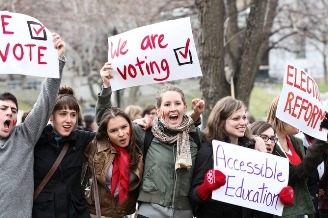The following piece was co-authored by HeadCount Executive Director Andy Bernstein and Rock the Vote President Ashley Spillane.
A week after the midterm election, you can hardly pick up a newspaper or turn on the TV without seeing a headline about disappointing turnout among Millennials this election cycle. We’d like to take this opportunity to say to all the Millennials out there – and to their critics –shake it off and take another look at the data.
In a horrendous political climate that left the majority of voters in the country opting out of this election, young voters didn’t succumb to this trend. According to data published by CIRCLE, Millennials comprised 13 percent of voters this year, up 2 percent from 2010, when youth voters counted for 11 percent of the electorate. They cast 9.9 million votes, up from 9 million four years before – a modest increase of 0.6 percent.
Meanwhile, overall turnout was down to its lowest levels since WWII.
We aren’t declaring victory. When barely one-in-four young people voted in this year’s election, we know there is so much more work to do. But the bottom line is: young people are actually bucking the national trend
They turned out in spite of growing up in an era of complete dysfunction in Washington, when approval ratings for Congress and party affiliations are at an all-time low. They turned out despite the lack of attention being paid to the issues they care most about. They turned out despite of the challenges erected to their participation through new voting laws all over the country.
Over the past two years alone, 10 states have passed restrictive voting laws purposefully intended to limit young people’s ability to register to vote and cast their ballots. This in spite of evidence that states with a photo voter ID law saw, on average, a4.4 percent lower turnout than those that did not.
In North Carolina, early voting was curtailed and same-day registration was eliminated. In Arizona and Kansas, efforts included requiring voters to provide proof of citizenship upon registering. In Tennessee, college professors could use their university IDs to vote, but students were barred from doing the same. And perhaps most absurdly: voters in Texas could use a gun license to vote, but not a student ID.
Yet, for every barrier erected to voting, a chorus of influential voices was heard engaging young voters.
Through our efforts at Rock the Vote and HeadCount, hundreds of high-wattage leaders in music and entertainment were raising awareness about the midterm election. The #TURNOUTFORWHAT music video and campaign featured cultural icons, many of them new voters themselves, sharing why they were turning out in a midterm election. The video – starring iconic Millennial voices like Lena Dunham and Darren Criss– was viewed online more than 11 million times and shared widely on social media, demonstrating that there is a strong appetite for content that inspires participation in and raises the visibility of a national event.
In parallel, HeadCount reached hundreds of thousands of young voters through an effort that spanned 700 concerts around the country, including tours by Jay-Z and Beyoncé, The Black Keys, and the Dave Matthews Band. That was followed by the most organized Election Day social media effort ever, racking up 350 million social media impressions behind the hash tag #GoVote with the help of cultural leaders like John Legend, Stephen Colbert, Jack Johnson and Linkin Park.
And on Election Day, Rock the Vote’s spokesperson, rapper Lil Jon, documented via his social media channels his own struggle to obtain an absentee ballot from election officials in his home state of Georgia, ultimately making the decision to fly to Atlanta in order to cast his vote on Election Day.
As a part of our coalition with civic engagement organizations, tech companies, and cultural leaders, our organizations registered nearly 700,000 voters this year – critical considering that 12,000 young people turn 18 each day.
The increase in youth voter turnout in 2014 sends a powerful message that many seem to be missing: even with so much working against them, Millennials are on the precipice of becoming the most influential voting bloc in the United States. This is the country’s largest and most diverse generation – over 90 million strong, with more than 43% identifying as non-white. Close to 90% say they gave to charity last year and close to 50% volunteer for causes they believe in.
Young people are the future, and this generation in particular wields incredible influence. Politicians and pundits should sit up and take notice; after all, Election Day 2016 is only 728 days away.
